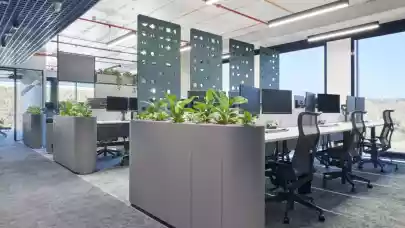
According to the latest insights from Colliers International, investment activity in commercial property in Europe is expected to rebound to reach €100 billion in Q4, following a robust turn-around in larger, post-COVID deals in Q3. This would take investment volumes for the whole year to around €270 billion, only 14 per cent down on activity in 2019, provided smoother waters prevail and the market isn’t further shocked by external geo-political or macro-economic factors.
Andy Thompson, Head of Investment for Czech and Slovak republics at Colliers said: “I think that in most of the institutional quality, sectors and sub-markets, almost any real estate transaction completed now has a high probability that it will look cheap in 18-24* months’ time from a yield perspective. *Barring a significantly deeper and longer recession than currently expected (in which case a number of other investment media will also be negatively impacted).”
“The majority of the stronger macro forces that have been driving pricing upwards over the last five years in most sectors are going to be even more significant over the next few years. In addition to that, in the Czech Republic, there are several local dynamics also pushing in the same direction (e.g. limited supply). The ultimate value will depend on how well the asset can be managed and whether it can retain or improve its income stream,” added Thompson.

Andy Thompson
Head of Investment Czech Republic & Slovakia
Colliers International
The publication of Prevail & Prosper, Colliers’ latest report on capital flows and CRE hotspots across EMEA looks at how the investment market is responding to the ways in which cities and sectors have reacted to the pandemic. It also explores how different city markets and capital destinations are positioned to benefit from the ongoing economic and investment market recovery that has picked up speed in Q3 2020.
Highlights from Prevail & Prosper include:
- 95 per cent of investors expect the market to recover in 12 months’ time according to Colliers’ investor survey.
- German, Swiss and French capital has been particularly active within EMEA, sustaining high inter-regional flows year-on-year.
- German and Nordic markets benefit from the most stable macro and political environments, and their mid-sized cities with alternative commuting solutions, low lease break risks and tight supply-demand conditions put them at the top of the core league table.
- London and Paris will not face diminished long-term economic positions despite several market uncertainties. This presents a great opportunity to buy into deep, core markets undergoing a price correction. London and UK regional cities are also attractive debt placement destinations, currently standing at significant premiums to other major European cities, due to limited competition.
- Logistics and residential investment have proven to be the most resilient sectors, sustaining high levels of investment. Colliers estimates over €3 billion of logistic portfolios alone has been introduced to the market this September, some of which have already closed, with values increasing by up to 20 per cent for core assets.
- Office investment volumes declined during Q2 and Q3, and pricing levels have started to adjust due to the uncertainty over perceptions of the future role of the workplace. As of September, while core asset pricing has moved by a few percentage points, values for core plus and Value-Add offices have declined by up to 20 per cent on active deals. The office’s vital role in driving revenue and economic output will not change, and our analysis of economic density vs rents on a spatial basis supports limited movement in long-term office rents and values.
- Retail and hospitality sectors will face extreme challenges and many smaller operators will not prevail in their current form, let alone prosper, as the market adjusts over the next 12-18 months. 2019 RevPAR levels for hotels have been severely impaired by the pandemic and are not likely to return to pre-COVID levels until the end of 2022 at the earliest.
Richard Divall, Head of Cross Border Capital Markets, EMEA explained: “Over Q3, sentiment and liquidity in the markets has improved, with larger transactions happening throughout Europe. As we enter the final quarter of the year, we are expecting to see a spike in volumes, as investors look to deploy some of their ‘dry powder’ and sellers become more confident with the depth of buyers and liquidity in the markets.
“Property sectors such as logistics, affordable residential, science parks and healthcare continue to attract more demand with investors taking caution and becoming highly selective in the other sectors. Of course, the market is still fragile, and external factors could send the market back into turbulence, including the US Election in November, and a second wave of the pandemic in Europe. However, if this can be avoided and smooth waters prevail, we could see investment volumes reach over €100 billion in Q4, doubling those of Q3 and Q2.”
Author of Prevail & Prosper, Damian Harrington, Head of EMEA research at Colliers Intonational concluded: “On the whole, activity across the region has been positive from an investment perspective – in relative terms – with overall H1 volumes only down by 10 per cent year-on-year. The anticipated rebound in Q4 would take EMEA to only 14 percent down year on year. While the second half of 2020 heralds the start of a recovery from the sharp lockdown-induced economic slump of Q2, the way in which markets are achieving a new normality continues to differ significantly by sector and by location.
“Depending on what side of the fence you sit, the market presents a bitter-sweet picture – bitter; if you’re holding a problematic asset in the wrong location, or sweet; for those with a war chest looking to seize opportunities or those able to sell logistics assets and portfolios at a premium.
“Whilst the recovery is positive, the immediate large ‘partial-V’ or ‘Swoosh’ rebound is over and national economies are facing a stealth position to get back to par. A K-type recovery of rebound-ready sectors, and those due to take a more protracted recovery, looks set to persist. Equally, the balance of factors influencing this recovery remains on the downside for now. As we’ve seen with the recent UK government announcement national governments need to balance-out measures that contain the virus by reducing mobility, whilst sustaining the economic recovery.”



